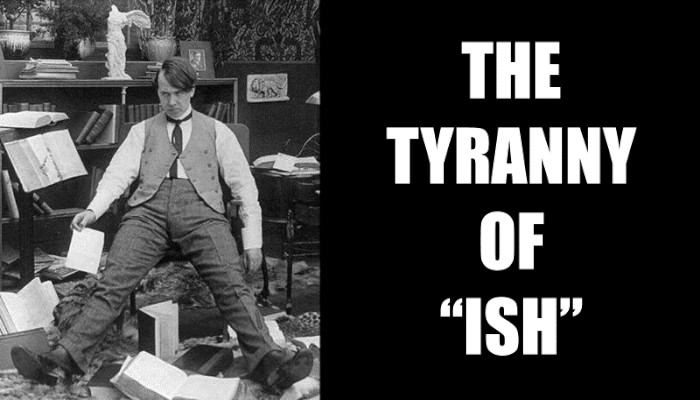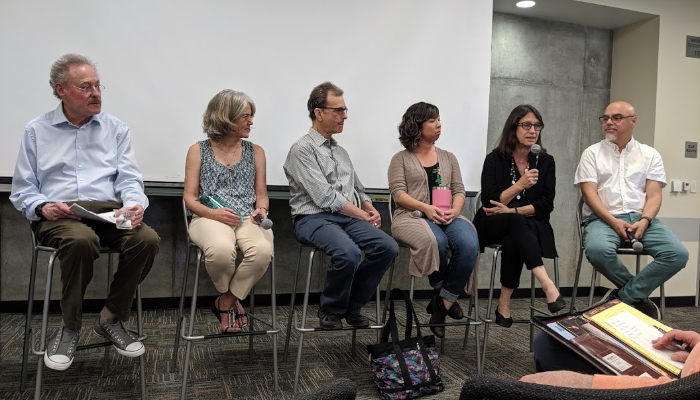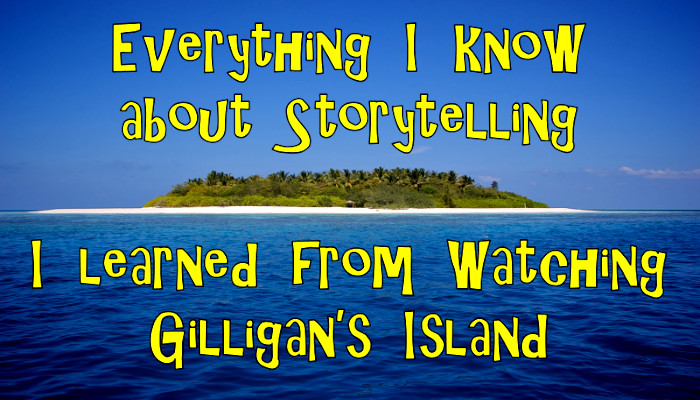by Ron Ploof | Nov 11, 2019 | Linguitics

I was presenting to a live online audience, had just explained Kendall Haven’s assertion that all humans learn through story structure, and then supported his claim with an example built upon Kenn Adams’ Story Spine.
Once upon a time there was a baby girl.
Everyday, someone comforted her when she cried.
Then one day, she cried and nobody came.
And because of that, she cried louder.
And because of that, she cried even louder.
Until finally, she noticed something. When it’s light outside, people comfort her. When it’s dark outside, they don’t.
And ever since then, she learned to sleep through the night.
The example illustrates how humans build new knowledge on top of existing knowledge by rectifying the differences between expected vs. actual outcomes.
After completing the example, I blurted some superlative like, “See what I mean? That’s exactly right.”
Evidently, someone in the audience took offense to my loose word-choice and typed, “Those with kids are not sure that’s *exactly* correct,” into the webinar’s live commenting system.
OMG. “That’s what you took from that?” I thought to myself. Putting aside the fact that my wife and I have raised two children–thank you very much–I wasn’t saying that ALL children learn to sleep through the night this way. I was demonstrating how people translate anomalies in their expectations into new knowledge through story structure. And while I obviously could have been clearer by tightening up my vague pronoun reference–which I likely would have caught had I been writing instead of speaking–this text-based critique felt familiar.
Recently, I’ve noticed a popular trend to focus on the literal as opposed to the figurative. When faced with a new idea, it’s popular to chip at its edges rather than focus on the main point. A shift in cultural norms has made it fashionable to major in minor things, sweat the small stuff, and dismiss arguments based on exceptions instead of the rules.
Historically, there have been two ways to deal with nitpickers: hold firm on the analogy’s main point or kowtow. The consequences of the latter are chilling. If humans are afraid to share new ideas, we lose the ability to communicate–the lifeblood of human interaction. And so, perhaps as an unintended consequence of this fear, a third option has emerged–a linguistic countermeasure designed to shield communicators from the snipers.
Here’s how it works. You start with an assertion like:
Diving into the shallow end of the pool is dangerous.
Then you soften the statement with a suffix, like this:
Diving into the shallow end of the pool is dangerous…ish.
“Ish” has become shorthand for “don’t shoot me if my statement doesn’t cover one hundred percent of your logical scenarios.” Had I been savvy enough to incorporate it into my talk by saying, “That’s exactly right…ish,” I would have insulated myself from the inflexibility of logic unabated. But, it also would have also watered down the concept I was trying to convey.
Let’s consider the effect of “ish” on the following sentences:
That’s just like the last time we went camping…ish.
He looks like George Clooney…ish.
Your hair is brown…ish.
This product is superior…ish.
That was the best movie ever…ish.
“Ish” is like a good-news-bad-news joke. The good news is that it holds the logic-snipers at bay. The bad news is that it debilitates strong statements.
I wrote an entire book on writing strong statements, so let’s see what happens when we “ish” a few proverbs.
A clean conscience makes a soft pillow…ish
Charity begins at home…ish
Discretion is the better part of valor…ish
Laughter is the best medicine…ish.
Lightning never strikes twice in the same place…ish
Oil and water don’t mix…ish
Old friends and old wine are best…ish
Patience is a virtue…ish
Communicating big concepts frequently requires speakers to employ meaning-approximation devices like simile, analogy, and metaphor. Unfortunately, since all will ultimately breakdown when exposed to the corrosive environment of pure logic, they’ve somehow become easy targets for those who choose to toil in the rhetorical margins.
The tyranny of “ish” is clear. Eroding our ability to convey deeper meaning inhibits our ability to think. For that reason alone, the practice must be stopped. Yet, to do so, we must attack “ish” on two fronts. First, communicators must hold firm on the message–refusing to kowtow to the logical snipers. Second, audiences must extend the benefit of the doubt. Rather than attacking an argument’s weak flanks with a barrage of Lilliputian attacks, what if we actually gave analogies, similes, and metaphors a little chance to breathe first?
Or we could just continue to lob hand grenades at them from the corners…ish.
Photo Credit: Translating a love letter from a Boston girl – “Now, does that mean yes or no?”. , ca. 1903. Photograph. https://www.loc.gov/item/2004668492/.
by Ron Ploof | Nov 4, 2019 | Storytelling

Telling Stories that Matter: Literary Journalism Workshop Panel. From left to right:
Barry Siegel, Amy DePaul, Miles Corwin, Erica Hayasaki, Amy Wilenz, and Hector Tobar.
The room was packed with over one hundred people interested in the art of storytelling–not bad for niche conference scheduled for 1:00 pm. on a hot SoCal Saturday afternoon. We’d gathered to learn about a new project from the UCI School of Humanities called the Center for Storytelling.
Professor Barry Siegel opened the event by describing the organization’s vision: to demystify the activity of writing and help the local community tell their stories. The Center for Storytelling has lofty goals, including raising $500,000 and building a Storytelling Lab, complete with recording technology and member-access to storytelling experts.
Siegel then joined a panel with five other colleagues to share their thoughts on both storytelling and writing. I’ve attempted to capture much of their storytelling wisdom.
On writers:
“Anyone who says that they love writing, probably isn’t a good writer.” Amy W.
“Writers are oddballs. Social outcasts.” Hector
“Writers are shy egomaniacs.” Miles ← the line of the day!
“I never met a great storyteller that wasn’t a big reader.” Miles
“If you steal from enough writers, you’ll develop your own style.” Hector
On becoming a better writer:
“You learn the most about writing by reading.” Barry
“To write you need nerve, will, and discipline.” Barry
“To be a storyteller, you must read stories like a writer.” Miles
“Read the masters.” Hector
“If you want to learn how to write a crime novel, read a good one and a bad one. You’ll learn more about structure from the bad one because good novels hide the mechanization.” Miles
Hector pointed to The Gettysburg Address as his benchmark for great writing: It’s short (265 words), powerful, and to the point.
On writing:
“Writing is a messy process that starts with flinging mud. Your first draft will be mud.” Barry
“It’s better to rely on excess in the first draft.” Hector
“Don’t start writing too soon.” Miles in response to question about writer’s block
Research…“If you don’t pay in the front end, you’ll pay in the backend.” Miles
“Have a schedule. I write a thousand words a day. No more. No less.” Miles
On interviewing:
“Be boring so that your subject can be interesting.” Amy W
“When interviewing a survivor, remember that they were a normal person first.” Hector
“Interviewers are like therapists that tell the world what they hear.” Hector
“Interviewing is like dating. It’s accelerated levels of intimacy.” Erica
On the impact of writing:
“When you’re reading The Silence of the Lambs and your heart starts pounding, remember that a writer did that to you.” Amy W
“People read to know what happens.” Hector
On storytelling:
“Look for moments that become scenes.” Erica
“People make stories interesting.” Miles
“People’s motivation must be on every page.” Hector
“Story begins with a world that you are interested in.” Erica
“Writing a story is a marathon. First you need to run around the block.” Hector
“Know your ending.” Hector
by Ron Ploof | Oct 20, 2019 | Business Storytelling

Stories are driven by great characters with unique motivations–and get interesting when those motivations clash. We see this every day in business. Before a prospect issues a purchase order, a host of characters must reconcile their motivational differences. Just think about the myriad of things that must align between you, your boss, your prospect, your prospect’s boss, and a collection of others, including competitors, investors, and vendors before any transaction.
The best business people understand what storytellers have known for ages: the best way to predict behavior is to understand what people want. Therefore, when storytellers create characters, they ask a simple question: “What do they want and why do they want it? By understanding what and why, storytellers establish guidelines for how characters react within specific situations.
Consider two famous characters: Detective Columbo (TV series) and Inspector Clouseau (The Pink Panther movies). Both Columbo and Clouseau are police detectives who want to solve a mystery, but each is motivated differently. Columbo pretends to be a bumbling detective, while Inspector Clouseau is a bumbling detective. Columbo solves his cases by staying one step ahead of his adversaries, while Inspector Clouseau stumbles into the truth through the hijinks of his ineptitude. Two characters with the same goal yet different motivations results in vastly different results. It’s all about the motivations.
So, how do you create a great characters that connect with audiences across generations? By studying successful ones. So let’s analyze Gilligan’s Island using the StoryHow™PitchDeck (SHPD).
Gilligan’s Island
Gilligan’s Island was a low-budget, campy sitcom filmed in the mid 1960s. Although it only ran for three seasons, it’s still in syndication today–more than fifty years later. Why? Because of the special ingredients that its writers tossed into their storytelling cauldron.
Just sit right back and you’ll hear a tale…
The song in the show’s opening title sequence describes four storytelling components: the Backstory (SHPD #30), Initial Impulse (SHPD #16), Setting (SHPD #6) and the castaways’ common motivation (SHPD #40 Throughline) to get back home.
Just sit right back and you’ll hear a tale, a tale of a fateful trip,
That started from this tropic port, aboard this tiny ship.
The mate was a mighty sailing man, the skipper brave and sure,
Five passengers set sail that day, on a three-hour tour,
A three-hour tour.
The weather started getting rough, the tiny ship was tossed,
If not for the courage of the fearless crew the Minnow would be lost,
The Minnow would be lost.
The ship set ground on the shore of this uncharted desert isle,
With Gilligan, the Skipper too,
The millionaire and his wife,
The movie star, Professor and Mary Ann,
Here on Gilligan’s Isle.
Minor Characters
Experienced storytellers know that good Minor Characters (SHPD #4) make better major characters.
The Island establishes the story’s Setting (SHPD #6), restricting the characters to one location. It’s the Catalyst (SHPD #9) that creates the Challenges (SHPD #53) of living in a benevolent prison–one that restricts castaway movements while simultaneously protecting them (SHPD #14) from the elements.
The Pacific Ocean is the castaway’s common foe and thus, Antagonist (SHPD #3). It’s the largest obstacle between them and their common goal: home.
The SS. Minnow is a Symbol (SHPD #57) of the castaway’s predicament. Just seeing it in the background reminds us that the castaways are trapped.
The Radio keeps the castaways connected to the outside by providing them with external Knowledge (SHPD #41).
The castaways use Coconuts for everything like: drinking cups, water-powered machines, the Professor’s experiments, and let’s not forget about Coconut Cream Pie.
Major Characters
The most important part of character development is determining what each character wants. This single piece of information drives all of their actions.
Jonas Grumby (The Skipper) wants to take care of the castaways. As their Captain, he’s driven by an Obligation (SHPD #34) to act as their Protector (SHPD #14). The Skipper’s Fatal Flaw (SHPD #11) is his inability to remain calm when Gilligan inevitably fouls something up. He is the Mirror (SHPD #7) to Gilligan.
Gilligan, the first mate, always wants to do the right thing, yet his good intentions frequently result in mayhem. His Superpower (SHPD #12) rests in his physical abilities to do things that the other castaways can’t, like run, jump, and climb coconut trees. Gilligan has two Fatal Flaws (11): he doesn’t think through his actions and Coconut Cream Pies are his kryptonite. Gilligan is the Mirror (SHPD #7) to the Skipper.
Thurston Howell III (Mr. Howell) wants to be the castaway’s leader because of his status on the mainland. He fails to understand that his money and status have no bearing on a deserted island. He’s a snob on the outside and a marshmallow on the inside. Even though his actions are Ironic (SHPD #56), he’s a respected elder and sometimes Mentor (SHPD #13).
Eunice “Lovey” Howell (Mrs.Howell) always wants to bring class to island activities. Her Fatal Flaw (SHPD # 11) is her inability to understand the actions of her working-class island mates. She is warmhearted and frequently comforts Mr. Howell when things inevitably don’t go his way.
Mary Ann Summers is a sweet, Kansas farm girl who wants to help everyone. Her most appealing attribute, her innocence, is also her Fatal Flaw (SHPD #11) because people can take advantage of her. She is the Mirror (SHPD #7) to Ginger.
Ginger Grant is an actress who wants to be the center of attention. Like the Howells, she’s used to getting her way. Ginger’s Superpower (SHPD # 12) is her ability to wrap the male Castaways around her little finger, while her Fatal Flaw (SHPD #11) is her inability to connect with people. Her Mirror (SHPD #7) is Mary Ann.
Roy Hinkley (The Professor) wants to solve all of the castaway’s problems. Whether it be finding a way off the island, making appliances out of bamboo, or recharging the radio’s batteries with coconut milk, the Professor is always trying to make life better for the castaways. His two Super Powers (SHPD #12) are Knowledge (SHPD #41) and Logical Choice (SHPD #33). His non-emotional way of attacking problems plays Mirror (SHPD #7) to the Skipper’s emotional reactions.
Episodes
Since Gilligan’s Island is a serial sitcom, the castaways can never leave the island. Therefore, each episode consists of a series of Recurring Events (SHPD #18) in the castaway’s common goal to get off the island. A typical episode involves the writers pumping the castaways with hope, and just when it looks like they’ll be rescued, one of Gilligan’s well-meaning actions scuttles the plan with a Setback (SHPD #23).
Final Thoughts
Gilligan’s Island is one of the most popular television series in broadcast history. But why? Was it the production value? Nope. The first season was filmed in black & white. Did it have the best writing? Nope. You could drive a truck through some of the holes in its Plot Points (SHPD #19). So, if the show suffered from such basic flaws, how did it enjoy so much success?
I have a few thoughts. First, it contains the raw ingredients of a good story: an odd collection of strong characters restricted to interact a tiny social microcosm. Add the fact that these characters were so relatable, we willingly suspend our belief to look past some of the plot-line inconsistencies. Lastly, and I think this is the most important one, we know theses characters by a single name. Just hearing someone talk about the Skipper, Gilligan, Mr. and Mrs. Howell, Mary Ann, Ginger, or the Professor, brings fond memories and make us smile.
Do you want to write a great story? Then create characters with a diverse set of wants. Ask, “What do they want and why do they want it?” Finally, put those characters into a situation, step back, and watch what happens. It worked for Gilligan’s Island and it might just work for you.
Photo Credit: Deserted Island by Mrs eNil through an Attribution-NonCommercial-NoDerivs 2.0 Generic (CC BY-NC-ND 2.0) license.


